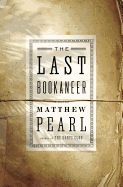
| Publisher: | Penguin Press | |
| Genre: | General, Fiction, Action & Adventure, Historical | |
| ISBN: | 9781594204920 | |
| Pub Date: | April 2015 | |
| Price: | $27.95 |
| Starred | Fiction |
by Matthew Pearl
Matthew Pearl's The Last Bookaneer is a grand adventure befitting Robert Louis Stevenson, a character in the novel. Populated with pirates, dwarfs, cannibals and even a tribal princess, this intricate story of literary swashbucklers ushers readers through the exotic landscapes of the South Seas on a treasure hunt for the written word.
Loopholes in early copyright laws enabled intellectual property to be stolen and sold in foreign countries to the highest publishing bidders. During that time, such a thief was known as a bookaneer--"a person capable of doing all that must be done in the universe of books that publishers, authors and readers can have no part in." The novel's narrator, Fergins, sails for Samoa at bookaneer Pen Davenport's side, to steal a dying Robert Louis Stevenson's final work for U.S. publication. Fergins and Davenport are racing the clock to secure the prized text before an international copyright treaty takes effect. But they aren't alone. Davenport's bitter enemy, Belial, also has his sights on Stevenson's manuscript.
Davenport and Belial battle to be the shrewdest operative, the one who secures the coveted manuscript. Each, waiting on the idiosyncratic Scottish novelist to declare his work finished, is unable to reveal the other's intentions without exposing himself. As readers anxiously wait to see whom the best man turns out to be, murder, mayhem and mystery ensue.
While Pearl revives some characters from his earlier novel, The Last Dickens, new readers needn't worry; no background is necessary to thoroughly enjoy this magnificently crafted escapade through the dangerous jungles of 19th-century publishing. The Last Bookaneer is a clever gem the bookaneers would undoubtedly steal. --Jen Forbus of Jen's Book Thoughts
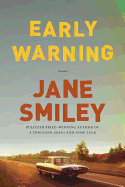
| Publisher: | Knopf | |
| Genre: | General, Fiction, Sagas, Historical | |
| ISBN: | 9780307700322 | |
| Pub Date: | April 2015 | |
| Price: | $26.95 |
| Fiction |
by Jane Smiley
Opening Early Warning, part two of Jane Smiley's projected Last Hundred Years trilogy, is like dropping in on a family reunion with the Langdons from 2014's Some Luck.
From 1953 through 1986, Early Warning covers the adult lives of the five children born to Walter and Rosanna Langdon on their farm in Denby, Iowa. The novel begins with Walter's funeral, where his children and grandchildren have convened. Only Joe, his second son, chose farm life. Predictably, Frank, the self-directed firstborn, enjoys postwar prosperity, taking measured risks in the weapons industry and real estate in metropolitan New York. At the wake, he and his brother-in-law Arthur, babies in tow, confer about politics and Stalin's death.
The characters are so vivid that even as the Langdons multiply, each remains distinctive: Frank's wife, Andy, obsesses over nuclear war; Henry, the youngest, conceals his homosexuality from his Midwestern family; the politically left Berkeley cousins include one who follows Rev. Jim Jones of the Peoples Temple. Romances, parenthood, births and deaths balance the historic themes as Walter and Rosanna's kids grow up in a modern era, in places far removed from their Iowa roots.
Rosanna keeps up with the times, and her growth is especially endearing as she learns to drive and maneuvers the world beyond Denby. Her experience--from horse-and-carriage days to Vietnam and Watergate--underscores the changes of her lifetime. It's good to know the Langdons will be back, entering the 21st century, in the last book of Smiley's trilogy. --Cheryl Krocker McKeon, manager, Book Passage, San Francisco
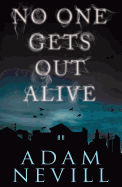
| Publisher: | St. Martin's Press | |
| Genre: | General, Fiction, Horror | |
| ISBN: | 9781250041289 | |
| Pub Date: | April 2015 | |
| Price: | $27.99 |
| Fiction |
by Adam Nevill
Like so many other Millennials, Stephanie has found steady employment difficult to come by since the Great Recession. After leaving her unstable stepmother's house and fleeing north to Birmingham, England, Stephanie is scraping by on temp jobs and living in a room she calls "the cell." Her fortunes seem to change when she finds an all-female boarding house offering relatively spacious rooms for low rent. She uses her entire meager savings on a deposit.
Unfortunately for Stephanie, her first night in 82 Edgehill Road includes an unwelcome encounter with the supernatural. By morning, she realizes moving into this dilapidated house was a grave mistake, one she hopes to rectify by getting her deposit back from the landlord. But slimy Knacker McGuire has other plans. He effectively holds Stephanie hostage by refusing her refund request. With no friends or family to turn to, and no money left in her bank account, Stephanie is forced to contend with increasingly terrifying supernatural phenomena. When Knacker's foul cousin, Fergal, shows up, Stephanie's situation becomes a matter of life or death.
Adam Nevill (Last Days; The Ritual) crafts a creepy if sometimes flawed story in No One Gets Out Alive. Stephanie's poor decision-making process, if a necessary genre staple, is absurd at times. The novel is overlong and makes a jarring temporal leap two-thirds of the way through. Despite these shortcomings, No One Gets Out Alive makes masterful work of an oppressively suspenseful atmosphere and antagonists readers will love to hate. Nevill excels at building dread and providing genuinely terrifying payoffs. --Tobias Mutter, freelance reviewer
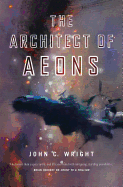
| Publisher: | Tor | |
| Genre: | Fiction, Science Fiction, Space Opera, Hard Science Fiction | |
| ISBN: | 9780765329707 | |
| Pub Date: | April 2015 | |
| Price: | $27.99 |
| Science Fiction & Fantasy |
by John C. Wright
Architect of Aeons, the fourth volume in John C. Wright's universe-spanning Count to a Trillion series, lives up to its name with a far-reaching speculative saga of post-human civilization.
Menelaus Montrose, an immortal post-human with a Texan drawl and a penchant for duels, has finally made an uneasy peace with fellow post-human Ximen del Azarchel as they work together despite their rivalry, and await the return of their love, Rania, from her long journey.
The two collude to steer the destiny of a human race that would be unrecognizable to current humanity, turning planets into artificially intelligent thinking beings with incomprehensible technologies and staggering amounts of power. Their intent is to stave off the inexorable advancement of a far-flung alien civilization possessing unrivaled power and intellect.
The story is by turns fast-paced and action-packed, while also thoughtful, philosophical and inwardly focused on what it means to be free and human, no matter the enhancements and changes on a molecular, even atomic, level.
Montrose is as moody and opinionated a character as Robert Heinlein ever wrote, and del Azarchel provides a brilliant, if somewhat more socially sophisticated, foil against which Montrose endlessly schemes, even while working with a common purpose. The two create a future for an eternally evolving humanity that--while full of difficult compromises--will allow Earth-originated life a place in a massive and uncaring universe.
Wright has created a dazzling vision of the remote future with compelling characters and vivid world building that deserves a place on any hard science fiction fan's bookshelf. --Rob LeFebvre, freelance writer and editor

| Publisher: | Oxmoor House | |
| Genre: | Travel, United States, Regional & Ethnic, American - Northwestern States, Cooking, American - California Style, West - Pacific | |
| ISBN: | 9780376083135 | |
| Pub Date: | April 2015 | |
| Price: | $22.95 |
| Food & Wine |
by Brigit Binns
West Coast vacationers know to pack sunscreen for California, raingear for Oregon and fleece for Washington. Here's more: Eating Up the West Coast is an essential new guide from Sunset magazine and Road Foodie blogger Brigit Binns (The New Wine Country Cookbook and many others), for travelers who rank cuisine as high as hikes, museums and natural wonders on their holiday to-do lists.
The road trips, restaurants and recipes in this fact- and photo-filled guide exclude the obvious: well-known urban eateries in Los Angeles, San Francisco, Portland and Seattle. In her truly off-the-beaten track ("OTBT") directory, Binns (and her dog, Stella) leads diners to Franny's Cup and Saucer (Point Arena, Calif.), Sharkbites Cafe (Coos Bay, Ore.), Pickled Fish (Long Beach, Wash.) and 38 other out-of-the-way establishments.
From "almost within hailing distance of the Mexican border" to Chuckanut Drive--"Washington's Big Sur"--35 miles from Canada, Eating Up the West Coast is divided into four geographic chapters and 12 convenient routes, with the mileage of each noted; for example, Route 7 is 201 miles, stretches from Talent, Ore., to Port Orford, Ore., and includes three restaurants.
Armchair travelers can share Binns's journey: 125 Sunset kitchen-tested recipes bring the featured dishes home, even accounting for regional ingredients ("substitute whatever wild and interesting domestic 'shrooms are available.").
With Binns's folksy stories of local history, each stop's chefs and diners, and enticing photos of the restaurants, food and scenery, Eating Up the West Coast begs to be your next travel guide. --Cheryl Krocker McKeon, manager, Book Passage, San Francisco

| Publisher: | Chronicle Books | |
| Genre: | Health & Healing, Low Fat, Cooking, Courses & Dishes, Desserts | |
| ISBN: | 9781452133003 | |
| Pub Date: | April 2015 | |
| Price: | $25 |
| Food & Wine |
by Joanne Chang
As a baker, Joanne Chang has devoted her life to sweets: "For me, the connection between baking sweets and happiness runs long and strong and it is indelible." In Baking with Less Sugar, Chang (co-owner and pastry chef at Boston's Flour Bakery and Café and co-owner of the Asian-inspired restaurant Myers and Chang) demonstrates that using less sugar can allow other flavors to shine, and the result is less about deprivation and more about celebration.
Her cookbook is not "a medical treatise on how to eat better or a diatribe against sugars." Chang relished the challenge of creating delicious desserts less dependent on refined sugars and accomplishes this in a variety of ways. First, she presents recipes that simply contain less sugar (about half a cup), like Pear-Cardamom-Walnut Scones and even a Yellow Birthday Cake with Fluffy Chocolate Ganache Frosting. Then she offers a selection of desserts with bittersweet chocolate as the only sweetener, like Deep-Dark-Chocolate Pudding Cakes and Chocolate Fudge-Bourbon Ice Cream. And she serves up treats that showcase honey (Honey Cashew Morning Buns and Vanilla Honey Rice Pudding), temptations with maple syrup or molasses (Maple-Bacon-Cheddar Biscuits and Maple-Pumpkin Pie) and finally fruit delights (like Pumpkin-Walnut Cheesecake Bars and Kabocha Squash Spice Cake).
Chang also explores the science of sweets, why sugar is addictive, as well as why low-sugar treats should be consumed within a day or two and tend to be lighter in color and tougher (but cakier) in texture. Even the most fervent sweet tooth will be satisfied with Baking with Less Sugar. --Kristen Galles from Book Club Classics
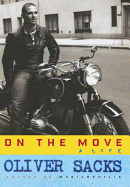
| Publisher: | Knopf | |
| Genre: | Cognitive Science, General, Cognitive Psychology & Cognition, Psychology, Biography & Autobiography, Medical, Science, Neurology | |
| ISBN: | 9780385352543 | |
| Pub Date: | April 2015 | |
| Price: | $27.95 |
| Biography & Memoir |
by Oliver Sacks
Neurologist Oliver Sacks (Hallucinations) is known for his patient-centered, narrative medical writing. On the Move picks up where his childhood memoir, Uncle Tungsten, left off.
The year Sacks turned 18, he got his first motorbike and reluctantly came out to his parents. He fell in love with historical scientific literature as a medical student at Oxford, and moved to North America a few years later, partly to get away from his "tragic, hopeless, mismanaged" schizophrenic brother. Sacks was a passionate motorcyclist, traveler, photographer and record-setting weightlifter, loved to swim in high seas, experimented with drugs and enjoyed his share of sexual adventures.
As Sacks neared middle age, injuries and heartbreak took their toll, and his drug use became a full-blown addiction. By 1966, he says, "my friends did not think I would make it to thirty-five, and neither did I." But he found a good analyst, gave up drugs and left lab research for clinical work. In 1967, he drafted his first book, Migraine, and began his life's work: research, writing and teaching--while also entering a 35-year romantic dry spell.
This is a finely written, calm and warmhearted memoir, with plenty of humor and little self-justification. Sacks brings his gift for intimate description to portraits of family, friends, co-workers and celebrities such as W.H. Auden, Robin Williams and Francis Crick. He has been an obsessive, lifelong journal-keeper and letter-writer, and his access to these documents gives his stories fresh and colorful immediacy. Few people live such a rich life, and fewer can tell it so well. --Sara Catterall
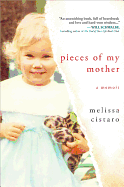
| Publisher: | Sourcebooks | |
| Genre: | Biography & Autobiography, Women, Personal Memoirs | |
| ISBN: | 9781492615385 | |
| Pub Date: | May 2015 | |
| Price: | $24.99 |
| Biography & Memoir |
by Melissa Cistaro
From the opening paragraphs of this poignant memoir, one wonders: What could spur a mother to leave her marriage, home and family--including this little girl beaming from the cover? And how did that child remember the moment? "I don't hear the sound of the car engine starting up, but I watch as my mom backs up and drives away in her baby-blue Dodge Dart." Melissa Cistaro was three, and in Pieces of My Mother she reflects on the 35 years between that day and the week in 2009 she spends by her mother's deathbed, seeking one answer above all others: Is she destined to fail as a mother, too?
In short chapters with a then-and-now format, Pieces of My Mother doesn't answer the "why," but Cistaro shares memories as well as a promising conclusion. "My mom didn't pass a 'leaving gene' on to me," she writes near the end, after she's discovered a cache of writing in her mother's filing cabinet: "Letters Never Sent & Thought Dabbles." So carefully pieced together are the stories of Melissa and her brothers growing up, the insights from her mother's witty and revealing writings and Cistaro's interpretation of it all, that the to-and-fro feels seamless. She remembers specifics of her coming of age in their California farmhouse, her mother's sporadic visits, her dad's efforts as a single parent. During her mother's last week, the writings offer comfort. "In her letters, I feel her full presence for the first time--the beautiful, complex, and full human being she was." Then, Cistaro returned home to her own waiting family. --Cheryl Krocker McKeon, manager, Book Passage, San Francisco
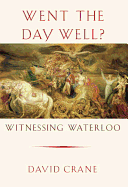
| Publisher: | Knopf | |
| Genre: | General, Great Britain - General, Western Europe, History, Social History, Europe, Napoleonic Wars, Military | |
| ISBN: | 9780307594921 | |
| Pub Date: | April 2015 | |
| Price: | $30 |
| Starred | History |
by David Crane
David Crane (Empires of the Dead) opens his history of the Battle of Waterloo by making a reference to Bruegel's painting Landscape with the Fall of Icarus, in which farmers plow their fields unaware of the boy falling from the sky. He offers the image as a metaphor for the way most people experience historical events--and for the approach he takes in Went the Day Well?: Witnessing Waterloo.
On June 18, 1815, Britons knew Napoleon was on the move across Europe, but they had no idea that the final battle of the Napoleonic Wars--and the defining event for a generation--was underway. At the heart of Crane's book lies the disjunction between the battle itself and the mundane details of that day in England.
The first section of the book is an hour-by-hour account, from midnight to midnight, of the day. Crane moves back and forth between Britain and Belgium, using diaries, newspapers and letters to give the perspective of poets, radicals, foot soldiers, officers and paupers. He introduces readers to a factory boy, a soon-to-be-widowed bride and a gothic novelist-cum-travel writer determined not to miss the most thrilling event of her time. The second, much shorter, portion of the book considers the aftermath of the battle, both for the individuals who appear in the prior section and for Britain as a whole.
Went the Day Well? is an unusual and illuminating account of Waterloo that will appeal to fans of the Napoleonic Wars and Regency history buffs alike. --Pamela Toler, blogging at History in the Margins
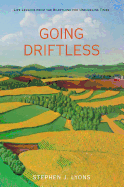
| Publisher: | Globe Pequot | |
| Genre: | Travel, United States, Sociology, State & Local - General, Agriculture & Food, History, Social Science, Regional Studies, Midwest - General, Rural | |
| ISBN: | 9780762780655 | |
| Pub Date: | May 2015 | |
| Price: | $16.95 |
| Travel Literature |
by Stephen J. Lyons
The remote hills and valleys of the Driftless are uncharacteristic of the Midwest, and these steeper slopes have sheltered alternative lifestyles for decades, from the back-to-the-landers who arrived in the 1970s to naturalists, traditional and organic farmers, artists, musicians and other singular souls living there today. Over several years, Lyons visits various Driftless communities, chatting with their leaders as well as others encountered by chance. He surveys farming and dairy cooperatives, families living off the grid, small business owners, food co-ops, a Zen monastery and successful planned communities. For example, Lyons outlines the history of Seed Savers Exchange, located near Decorah, Iowa, which curates a collection of more than 20,000 seed varietals from around the world in the public domain. The region attracts those interested in getting back to basics, hoping to build communities.
Going Driftless comprises a series of sketches of people, places and organizations, and steers clear of judgment or conclusion in favor of quiet contemplation. Lyons gently suggests near the book's end that these unobtrusive lifestyles have something to offer in unstable times. --Julia Jenkins, librarian and blogger at pagesofjulia
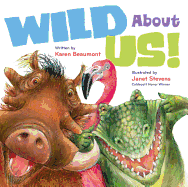
| Publisher: | Houghton Mifflin Harcourt | |
| Genre: | Animals, Self-Esteem & Self-Reliance, Social Issues, Juvenile Fiction, Stories in Verse, Zoos | |
| ISBN: | 9780152062941 | |
| Pub Date: | April 2015 | |
| Price: | $16.99 |
| Starred | Children's & Young Adult |
by Karen Beaumont, illust. by Janet Stevens
Karen Beaumont's (I Ain't Gonna Paint No More!) exuberant rhyming extravaganza salutes the characteristics that make each creature distinct, with portraits from Janet Stevens (Tops & Bottoms) that exploit the humorous possibilities.
"I'm warty warthog!/ Can't be who I'm not./ I am who I am,/ and I've got what I've got," says the furry fellow, with tusks spanning nearly a full page, and a fly perched on his snout. That fly appears on every creature, from Crocodile's rear leg to Rhino's front tusk ("Crocodile's proud/ of his big/ toothy grin./ Rhino feels fine in her.../ wrinkly skin"). The design plays up each singular feature cited in the text: "toothy grin" appears in a thick serif font that looks like blades and sharp edges; "lanky" and "tall" for Giraffe stretches down the page in all caps and fine lines. "Would you dare tell Flamingo/ he shouldn't be pink?/ Or Potbellied Pig she's too/ plump, do you think?" ("Plump" appears in a light-green type doughy enough to eat.) In one of the funniest portraits, poor Porcupine looks like she's having the worst bad hair day ever ("Does Porcupine care that she can't curl her hair?")
Stevens keeps the mood light while also rendering animals with soulful eyes who see themselves clearly. "We're glad we're all different!/ It would be such a shame/ if you came to the zoo.../ and we all looked the same!" This subtle commentary about accepting who you are challenges gender stereotypes and suggests true beauty lies in how we see ourselves. --Jennifer M. Brown, children's editor, Shelf Awareness

| Publisher: | Capstone | |
| Genre: | Media Tie-In, Juvenile Fiction | |
| ISBN: | 9781630790059 | |
| Pub Date: | May 2015 | |
| Price: | $16.95 |
| Children's & Young Adult |
by Gwenda Bond
Gwenda Bond concocts an intelligent novel that moves faster than a speeding bullet, with an original story about Lois Lane's teen life and a mysterious online pen pal called "SmallvilleGuy."
Lois has moved more times than she'd like to admit. Her military father insists that this time they're setting down roots in Metropolis (a thinly disguised New York City), so Lois better keep her head down. Within her first hour at her new school, Lois overhears an earnest student, Anavi, describing to the principal the bullying she's experiencing from a band of gamers. The principal, about to introduce a guest for assembly, brushes off Anavi's complaints, and Lois butts in, to Anavi's horror. The guest, an editor at the Daily Planet, asks Lois to join his online teen news forum, the Daily Scoop. Lois becomes the reader's guide to a gaming-military initiative so complex that even the designers of the game don't realize how far-reaching its side effects are. The Warheads recruit talented gamers and conscript them into a kind of hive mind, completing each other's sentences and moving in synch.
Bond's high-stakes plot keeps the pages turning; the teens solve their problems themselves without Superman's superpowers to save the day. The author mixes in the rewards of friendship and a hint of romance. Lois proves a model of trusting one's instincts and standing up for what's right--the rest will follow. May this be the first of many more. --Jennifer M. Brown, children's editor, Shelf Awareness